Research Progress of Urban Park Microclimate Based on Quantitative Statistical Software
Abstract
:1. Introduction
2. Materials and Methods
- Data Import: Import the selected literature data into Citespace (6.1.2 Official release) or VOSviewer (V1.6.18 official release) software. Set options according to the research needs, including time range, keyword settings, and merging author names.
- Keyword Extraction: Extract keywords and their associations from the literature. Through keyword co-occurrence analysis and clustering analysis, reveal the relationships between keywords and the development frontiers of research topics.
- Construction of Citation Networks: Citespace and VOSviewer can construct citation networks by analyzing citation relationships, showcasing academic communication and collaboration in the research field.
- Visualization of Results: Citespace and VOSviewer present the results of keyword co-occurrence analysis or citation network analysis in a visual manner, such as topology maps and temporal graphs, to intuitively display the knowledge structure and development trends in the research field [36].
3. Results
3.1. Research Status of the Urban Microclimate
3.1.1. Study Scale and Scope of Influence
3.1.2. Progress
3.1.3. Countries and Regions under Study
3.2. Cluster Analysis of Keyword Co-Citation
3.3. Research and Development Stage of the Microclimate in Urban Parks
3.3.1. Dynamic Changes and Differentiation of Keywords
3.3.2. Four Stages of Microclimate Research in Urban Parks
4. Research Hotspots
4.1. Distribution of Research Hotspots Based on Keyword Clustering
4.2. Frontier Analysis and Hot Spot Prediction Based on Keyword Emergence
5. Future Directions
5.1. Future Research Directions
5.2. Multidisciplinary Convergence Analysis Study
5.3. Prospects of Numerical Simulation Studies
6. Conclusions
Author Contributions
Funding
Data Availability Statement
Conflicts of Interest
References
- AlKazimi, M.A.; Grantham, K. Investigating new risk reduction and mitigation in the oil and gas industry. J. Loss Prev. Process Ind. 2015, 34, 196–208. [Google Scholar] [CrossRef]
- Al-Kasasbeh, M.; Mujalli, R.O.; Abudayyeh, O.; Liu, H.; Altalhoni, A. Bayesian Network Models for Evaluating the Impact of Safety Measures Compliance on Reducing Accidents in the Construction Industry. Buildings 2022, 12, 1980. [Google Scholar] [CrossRef]
- Ratnayake, R.C. Ratnayake Sustainable performance of industrial assets: The role of PAS 55-1&2 and human factors. Int. J. Sustain. Eng. 2013, 6, 198–211. [Google Scholar]
- Faertes, D. Reliability of supply chains and business continuity management. Procedia Comput. Sci. 2015, 55, 1400–1409. [Google Scholar] [CrossRef]
- Gulati, R. Maintenance and Reliability Best Practices; Industrial Press: New York, NY, USA, 2012. [Google Scholar]
- ISO 55000:2014; Asset Management—Overview, Principles and Terminology. International Organization for Standardization: London, UK, 2014.
- ISO 22301:2019; Security and Resilience—Business Continuity Management Systems—Requirements. International Organization for Standardization: London, UK, 2019.
- Torabi, S.A.; Soufi, H.R.; Sahebjamnia, N. A new framework for business impact analysis in business continuity management (with a case study). Saf. Sci. 2014, 68, 309–323. [Google Scholar] [CrossRef]
- Xiahou, X.; Chen, J.; Zhao, B.; Yan, Z.; Cui, P.; Li, Q.; Yu, Z. Research on Safety Resilience Evaluation Model of Data Center Physical Infrastructure: An ANP-Based Approach. Buildings 2022, 12, 1911. [Google Scholar] [CrossRef]
- Davies, R.; Dieter, J.; McGrail, T. The IEEE and asset management: A discussion paper. In Proceedings of the IEEE Power and Energy Society General Meeting, Detroit, MI, USA, 24–28 July 2011; pp. 1–5. [Google Scholar]
- Tracey, S.; O’Sullivan, T.L.; Lane, D.E.; Guy, E.; Courtemanche, J. Promoting resilience using an asset-based approach to business continuity planning. SAGE Open 2017, 7, 2158244017706712. [Google Scholar] [CrossRef]
- Yazdani, M.; Mojtahedi, M.; Loosemore, M. Enhancing evacuation response to extreme weather disasters using public transportation systems: A novel simheuristic approach. J. Comput. Des. Eng. 2020, 7, 195–210. [Google Scholar] [CrossRef]
- Abbaspour, S.; Aghsami, A.; Jolai, F.; Yazdani, M. An integrated queueing-inventory-routing problem in a green dual-channel supply chain considering pricing and delivery period: A case study of construction material supplier. J. Comput. Des. Eng. 2022, 9, 1917–1951. [Google Scholar] [CrossRef]
- Roostaie, S.; Nawari, N. The DEMATEL approach for integrating resilience indicators into building sustainability assessment frameworks. Build. Environ. 2021, 207, 108113. [Google Scholar] [CrossRef]
- Aghabegloo, M.; Rezaie, K.; Torabi, S.A. Physical Asset Risk Management: A Case Study from an Asset-Intensive Organization. In The International Symposium for Production Research; Lecture Notes in Mechanical Engineering; Springer: Cham, Switzerland, 2020; pp. 667–678. [Google Scholar]
- Collier, Z.A.; Wang, D.; Vogel, J.T.; Tatham, E.K.; Linkov, I. Sustainable roofing technology under multiple constraints: A decision-analytical approach. Environ. Syst. Decis. 2013, 33, 261–271. [Google Scholar] [CrossRef]
- Azfar, K.R.; Khan, N.; Gabriel, H.F. Performance measurement: A conceptual framework for supply chain practices. Procedia Soc. Behav. Sci. 2014, 150, 803–812. [Google Scholar] [CrossRef]
- Pillay, A.; Wang, J. Modified failure mode and effects analysis using approximate reasoning. Reliab. Eng. Syst. Saf. 2003, 79, 69–85. [Google Scholar] [CrossRef]
- Márquez, A.C.; De Leõn, P.M.; Rosique, A.S.; Fernández, J.F.G. Criticality Analysis for Maintenance Purposes: A Study for Complex In-service Engineering Assets. Qual. Reliab. Eng. Int. 2016, 32, 519–533. [Google Scholar] [CrossRef]
- Muganyi, P.; Mbohwa, C.; Madanhire, I. Warranting physical assets reliability through criticality optimization. In Proceedings of the International Conference on Industrial Engineering and Operations Management, Girona, Spain, 12–13 July 2018; pp. 3383–3393. [Google Scholar]
- Parajes, S.; Adolfo, J.; Márquez, C.; Sola, A. Rosique Criticality analysis for preventive maintenance optimization purposes in gas network infrastructures. Proc. Inst. Mech. Eng. Part O J. Risk Reliab. 2018, 232, 464–472. [Google Scholar]
- Antomarioni, S.; Ciarapica, F.E.; Bevilacqua, M. Association rules and social network analysis for supporting failure mode effects and criticality analysis: Framework development and insights from an onshore platform. Saf. Sci. 2022, 150, 105711. [Google Scholar] [CrossRef]
- Shahri, M.M.; Jahromi, A.E.; Houshmand, M. An integrated fuzzy inference system and AHP approach for criticality analysis of assets: A case study of a gas refinery. J. Intell. Fuzzy Syst. 2021, 41, 199–217. [Google Scholar] [CrossRef]
- Bocchini, P.; Frangopol, D.M.; Ummenhofer, T.; Zinke, T. Resilience and sustainability of civil infrastructure: Toward a unified approach. J. Infrastruct. Syst. 2014, 20, 04014004. [Google Scholar] [CrossRef]
- Keshtkar, A.R.; Salajegheh, A.; Sadoddin, A.; Allan, M.G. Application of Bayesian networks for sustainability assessment in catchment modeling and management (Case study: The Hablehrood river catchment). Ecol. Model. 2013, 268, 48–54. [Google Scholar] [CrossRef]
- Santos, T.; Silva, F.J.G.; Ramos, S.F.; Campilho, R.D.S.G.; Ferreira, L.P. Asset Priority Setting for Maintenance Management in the Food Industry. In Proceedings of the 29th International Conference on Flexible Automation and Intelligent Manufacturing (FAIM2019), Limerick, Ireland, 24–28 June 2019; Volume 15, pp. 699–706. [Google Scholar]
- Snedaker, S.; Rima, C. Business Impact Analysis. In Business Continuity and Disaster Recovery Planning for IT Professionals, 2nd ed.; Syngress: Oxford, UK, 2015; pp. 225–274. [Google Scholar]
- Kure, H.I.; Islam, S.; Ghazanfar, M.; Raza, A.; Pasha, M. Asset criticality and risk prediction for an effective cybersecurity risk management of cyber-physical system. Neural Comput. Appl. 2022, 34, 493–514. [Google Scholar] [CrossRef]
- Syachrani, S.; Jeong, H.D.; Chung, C.S. Advanced criticality assessment method for sewer pipeline assets. Water Sci. Technol. 2013, 67, 1302–1309. [Google Scholar] [CrossRef] [PubMed]
- Beyza, J.; Garcia-Paricio, E.; Yusta, J.M. Ranking critical assets in interdependent energy transmission networks. Electr. Power Syst. Res. 2019, 172, 242–252. [Google Scholar] [CrossRef]
- Solomon, J.D.; Oldach, J. Forced rank methodologies to more efficiently perform criticality analysis. In Proceedings of the 2016 Annual Reliability and Maintainability Symposium (RAMS), Tucson, AZ, USA, 25–28 January 2016; pp. 2–7. [Google Scholar]
- Cha, S.-C.; Juo, P.-W.; Liu, L.-T.; Chen, W.-N. RiskPatrol: A risk management system considering the integration risk management with business continuity processes. In Proceedings of the IEEE International Conference on Intelligence and Security Informatics, Taipei, Taiwan, 17–20 June 2008; pp. 110–115. [Google Scholar]
- Sikdar, P. Alternate approaches to business impact analysis. Inf. Secur. J. Glob. Perspect. 2011, 20, 128–134. [Google Scholar] [CrossRef]
- Heng, G.M. Conducting Your Impact Analysis for Business Continuity Planning; GMH Continuity Architects: Singapore, 2002. [Google Scholar]
- Marchese, D.; Reynolds, E.; Bates, M.E.; Morgan, H.; Clark, S.S.; Linkov, I. Resilience and sustainability: Similarities and differences in environmental management applications. Sci. Total Environ. 2018, 613–614, 1275–1283. [Google Scholar] [CrossRef] [PubMed]
- Rezaei, J. Best-worst multi-criteria decision-making method. Omega 2015, 53, 49–57. [Google Scholar] [CrossRef]
- Kaklauskas, A.; Zavadskas, E.K.; Binkyte-Veliene, A.; Kuzminske, A.; Cerkauskas, J.; Cerkauskiene, A.; Valaitiene, R. Multiple criteria evaluation of the EU country sustainable construction industry lifecycles. Appl. Sci. 2020, 10, 3733. [Google Scholar] [CrossRef]
- Tupenaite, L.; Kaklauskas, A.; Lill, I.; Geipele, I.; Naimaviciene, J.; Kanapeckiene, L.; Kauskale, L. Sustainability assessment of the new residential projects in the Baltic States: A multiple criteria approach. Sustainability 2018, 10, 1387. [Google Scholar] [CrossRef]
- Kamranfar, S.; Azimi, Y.; Gheibi, M.; Fathollahi-Fard, A.M.; Hajiaghaei-Keshteli, M. Analyzing green construction development barriers by a hybrid decision-making method based on DEMATEL and the ANP. Buildings 2022, 12, 1641. [Google Scholar] [CrossRef]
- Gheibi, M.; Eftekhari, M.; Akrami, M.; Emrani, N.; Hajiaghaei-Keshteli, M.; Fathollahi-Fard, A.M.; Yazdani, M. A sustainable decision support system for drinking water systems: Resiliency improvement against cyanide contamination. Infrastructures 2022, 7, 88. [Google Scholar] [CrossRef]
- Khan, F.I.; Haddara, M.M. Risk-based maintenance (RBM): A quantitative approach for maintenance/inspection scheduling and planning. J. Loss Prev. Process Ind. 2003, 16, 561–573. [Google Scholar] [CrossRef]
- Gupta, H.; Barua, M. Kumar. A novel hybrid multi-criteria method for supplier selection among SMEs on the basis of innovation ability. Int. J. Logist. Res. Appl. 2018, 21, 201–223. [Google Scholar] [CrossRef]
- Rostam, M.G.; Abbasi, A. A framework for identifying the appropriate quantitative indicators to objectively optimize the building energy consumption considering sustainability and resilience aspects. J. Build. Eng. 2021, 44, 102974. [Google Scholar] [CrossRef]
- Meacham, B.J. Sustainability and resiliency objectives in performance building regulations. Build. Res. Inf. 2016, 44, 474–489. [Google Scholar] [CrossRef]
- Moosavi, J.; Fathollahi-Fard, A.M.; Dulebenets, M.A. Supply chain disruption during the COVID-19 pandemic: Recognizing potential disruption management strategies. Int. J. Disaster Risk Reduct. 2022, 75, 102983. [Google Scholar] [CrossRef]
- Soleiman, H.; Chhetri, P.; Fathollahi-Fard, A.M.; Al-e-Hashem, S.M.J.; Shahparvari, S. Sustainable closed-loop supply chain with energy efficiency: Lagrangian relaxation, reformulations and heuristics. Ann. Oper. Res. 2022, 318, 531–556. [Google Scholar] [CrossRef]
- Rajesh, R. Optimal trade-offs in decision-making for sustainability and resilience in manufacturing supply chains. J. Clean. Prod. 2021, 313, 127596. [Google Scholar] [CrossRef]
- Tang, J.; Heinimann, H.; Han, K.; Luo, H.; Zhong, B. Evaluating Resilience in Urban Transportation Systems for Sustainability: A Systems-Based Bayesian Network Model. Transp. Res. Part C Emerg. Technol. 2020, 121, 102840. [Google Scholar] [CrossRef]
- Hossain, N.U.I.; Nur, F.; Hosseini, S.; Jaradat, R.; Marufuzzaman, M.; Puryear, S.M. A Bayesian network based approach for modeling and assessing resilience: A case study of a full-service deep water port. Reliab. Eng. Syst. Saf. 2019, 189, 378–396. [Google Scholar] [CrossRef]
- Hosseini, S.; Barker, K. Modeling infrastructure resilience using Bayesian networks: A case study of inland waterway ports. Comput. Oper. Res. 2016, 66, 233–248. [Google Scholar] [CrossRef]
- Molina-Serrano, B.; González-Cancelas, N.; Soler-Flores, F. Analysis of the port sustainability parameters through Bayesian networks. Environ. Sustain. Indic. 2020, 6, 100030. [Google Scholar] [CrossRef]
- Sierra, L.A.; Yepes, V.; García-Segura, T.; Pellicer, E. Bayesian network method for decision-making about the social sustainability of infrastructure projects. J. Clean. Prod. 2018, 176, 521–534. [Google Scholar] [CrossRef]
- El Amrani, S.; Hossain, N.U.I.; Karam, S.; Jaradat, R.; Nur, F.; Hamilton, M.A.; Ma, J. Modelling and assessing sustainability of a supply chain network leveraging multi-Echelon Bayesian Network. J. Clean. Prod. 2021, 302, 126855. [Google Scholar] [CrossRef]
- Jaderi, F.; Ibrahim, Z.; Zahiri, M. Reza. Criticality analysis of petrochemical assets using risk-based maintenance and the fuzzy inference system. Process Saf. Environ. Prot. 2019, 121, 312–325. [Google Scholar] [CrossRef]
- Yazdani, M.; Khalili, S.M.J.; Babagolzadeh, M.; Jolai, F. A single-machine scheduling problem with multiple unavailability constraints: A mathematical model and an enhanced variable neighborhood search approach. J. Comput. Des. Eng. 2017, 4, 46–59. [Google Scholar] [CrossRef]
- Mi, X.; Tang, M.; Liao, H.; Shen, W.; Lev, B. The state-of-the-art survey on integrations and applications of the best worst method in decision making: Why, what, what for and what’s next? Omega 2019, 87, 205–225. [Google Scholar] [CrossRef]
- Karimi, H.; Sadeghi-Dastaki, M.; Javan, M. A fully fuzzy best—Worst multi-attribute decision making method with triangular fuzzy number: A case study of maintenance assessment in the hospitals. Appl. Soft Comput. 2020, 86, 105882. [Google Scholar] [CrossRef]
- Guo, S.; Zhao, H. Fuzzy best-worst multi-criteria decision-making method and its applications. Knowl.-Based Syst. 2017, 121, 23–31. [Google Scholar] [CrossRef]
- World Commission on Environment and Development. Our Common Future; Oxford University Press: Oxford, UK, 1987. [Google Scholar]
- Brandenburg, M.; Govindan, K.; Sarkis, J.; Seuring, S. Quantitative models for sustainable supply chain management: Developments and directions. Eur. J. Oper. Res. 2014, 233, 299–312. [Google Scholar] [CrossRef]
- Ding, G.K.; Wu, C.; Yu, L. Developing a multicriteria approach for the measurement of sustainable performance. Build. Res. Inf. 2005, 33, 3–16. [Google Scholar] [CrossRef]
- Winroth, M.; Almström, P.; Andersson, C. Sustainable indicators at factory level-a framework for practical assessment. In Proceedings of the IIE Annual Conference, Orlando, FL, USA, 19–23 May 2012; p. 1. [Google Scholar]
- API. 581-Recommended Practice for Risk-Based Inspection Methodology; API: Camellia, Australia, 2016. [Google Scholar]
- Liu, B.; Xue, B.; Chen, X. Development of a metric system measuring infrastructure sustainability: Empirical studies of Hong Kong. J. Clean. Prod. 2021, 278, 123904. [Google Scholar] [CrossRef]
- Fernández-Sánchez, G.; Rodríguez-López, F. A methodology to identify sustainability indicators in construction project management—Application to infrastructure projects in Spain. Ecol. Indic. 2010, 10, 1193–1201. [Google Scholar] [CrossRef]
- Akhtar, S.; Reza, B.; Hewage, K.; Shahriar, A.; Zargar, A.; Sadiq, R. Life cycle sustainability assessment (LCSA) for selection of sewer pipe materials. Clean Technol. Environ. Policy 2015, 17, 973–992. [Google Scholar] [CrossRef]
- Islam, R.; Nazifa, T.H.; Mohamed, S.F. Evaluation of facilities management sustainable parameters for improving operational efficiency. Int. J. Constr. Manag. 2021, 21, 538–554. [Google Scholar] [CrossRef]
- Alnoaimi, A.; Rahman, A. Sustainability assessment of sewerage infrastructure projects: A conceptual framework. Int. J. Environ. Sci. Dev. 2019, 10, 23–29. [Google Scholar] [CrossRef]
- Haimes, Y.Y. On the definition of resilience in systems. Risk Anal. Int. J. 2009, 29, 498–501. [Google Scholar] [CrossRef]
- Hosseini, S.; Barker, K.; Ramirez-Marquez, J. Emmanuel. A review of definitions and measures of system resilience. Reliab. Eng. Syst. Saf. 2016, 145, 47–61. [Google Scholar] [CrossRef]
- Zobel, C.W.; Khansa, L. Characterizing multi-event disaster resilience. Comput. Oper. Res. 2014, 42, 83–94. [Google Scholar] [CrossRef]
- Panteli, M.; Mancarella, P.; Trakas, D.N.; Kyriakides, E.; Hatziargyriou, N.D. Metrics and quantification of operational and infrastructure resilience in power systems. IEEE Trans. Power Syst. 2017, 32, 4732–4742. [Google Scholar] [CrossRef]
- Jovanović, A.; Klimek, P.; Renn, O.; Schneider, R.; Øien, K.; Brown, J.; DiGennaro, M.; Liu, Y.-T.; Pfau, V.; Jelić, M.; et al. Assessing resilience of healthcare infrastructure exposed to COVID-19: Emerging risks, resilience indicators, interdependencies and international standards. Environ. Syst. Decis. 2020, 40, 252–286. [Google Scholar] [CrossRef]
- Argyroudis, S.; Dyrkorn, A.; Straub, D. Resilience metrics for transport networks: A review and practical examples for bridges. Inst. Civ. Eng.-Bridge Eng. 2022, 175, 179–192. [Google Scholar] [CrossRef]
- Ayyub, B.M. Systems resilience for multihazard environments: Definition, metrics, and valuation for decision making. Risk Anal. Int. J. 2014, 34, 340–355. [Google Scholar] [CrossRef] [PubMed]
- Labaka, L.; Hernantes, J.; Sarriegi, J.M. A holistic framework for building critical infrastructure resilience. Technol. Forecast. Soc. Change 2016, 103, 21–33. [Google Scholar] [CrossRef]
- Moghadas, M.; Asadzadeh, A.; Vafeidis, A.; Fekete, A.; Kötter, T. A multi-criteria approach for assessing urban flood resilience in Tehran, Iran. Int. J. Disaster Risk Reduct. 2019, 35, 101069. [Google Scholar] [CrossRef]
- Zavadskas, E.K.; Kaklauskas, A.; Sarka, V. The new method of multicriteria complex proportional assessment of projects. Technol. Econ. Dev. Econ. 1994, 3, 131–139. [Google Scholar]
- Kaklauskas, A. Degree of project utility and investment value assessments. Int. J. Comput. Commun. Control 2016, 11, 666–683. [Google Scholar] [CrossRef]
- Liou, J.J.H. Developing an integrated model for the selection of strategic alliance partners in the airline industry. Knowl. Based Syst. 2012, 28, 59–67. [Google Scholar] [CrossRef]
- Kaya, R.; Yet, B. Building Bayesian networks based on DEMATEL for multiple criteria decision problems: A supplier selection case study. Expert Syst. Appl. 2019, 134, 234–248. [Google Scholar] [CrossRef]
- Choua, Y.-C.; Sun, C.-C.; Yen, H.-Y. Evaluating the criteria for human resource for science and technology (HRST) based on an integrated fuzzy AHP and fuzzy DEMATEL approach. Appl. Soft Comput. 2012, 12, 64–71. [Google Scholar] [CrossRef]
- Yazdani, M.; Jolai, F. Lion optimization algorithm (LOA): A nature-inspired metaheuristic algorithm. J. Comput. Des. Eng. 2016, 3, 24–36. [Google Scholar] [CrossRef]
- Tzeng, G.-H.; Chiang, C.-H.; Li, C.-W. Evaluating intertwined effects in e-learning programs: A novel hybrid MCDM model based on factor analysis and DEMATEL. Expert Syst. Appl. 2007, 32, 1028–1044. [Google Scholar] [CrossRef]
- Fenton, N.; Neil, M. Risk Assessment and Decision Analysis with Bayesian Networks; CRC Press: Boca Raton, FL, USA, 2018. [Google Scholar]
- Fahimnia, B.; Jabbarzadeh, A. Marrying supply chain sustainability and resilience: A match made in heaven. Transp. Res. Part E Logist. Transp. Rev. 2016, 91, 306–324. [Google Scholar] [CrossRef]
- Varkey, D.A.; Pitcher, T.J.; McAllister, M.K.; Sumaila, R.S. Bayesian decision-network modeling of multiple stakeholders for reef ecosystem restoration in the Coral Triangle. Conserv. Biol. 2013, 27, 459–469. [Google Scholar] [CrossRef] [PubMed]
- Kammouh, O.; Gardoni, P.; Cimellaro, G.P. Probabilistic framework to evaluate the resilience of engineering systems using Bayesian and dynamic Bayesian networks. Reliab. Eng. Syst. Saf. 2020, 198, 106813. [Google Scholar] [CrossRef]
- Sarwar, A.; Khan, F.; James, L.; Abimbola, M. Integrated offshore power operation resilience assessment using Object Oriented Bayesian network. Ocean Eng. 2018, 167, 257–266. [Google Scholar] [CrossRef]


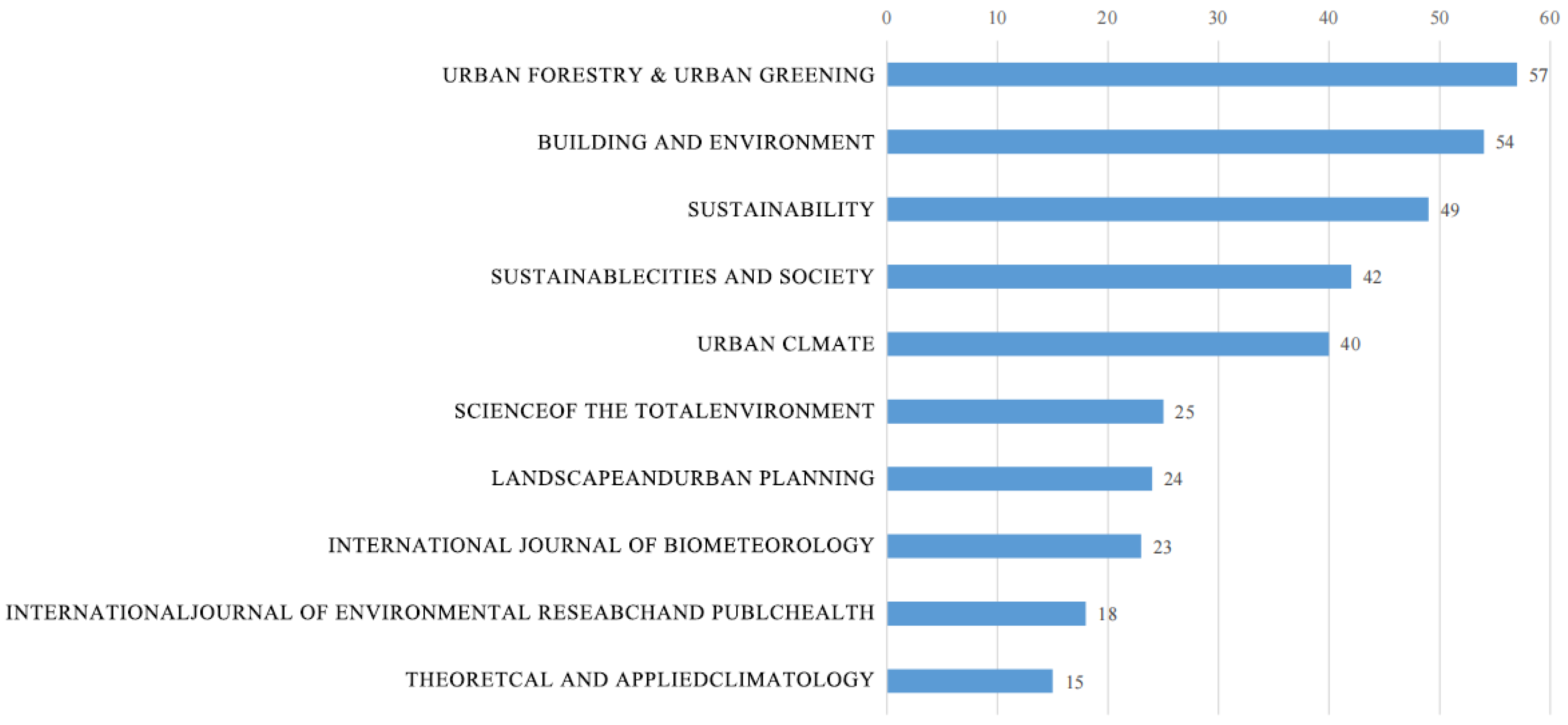

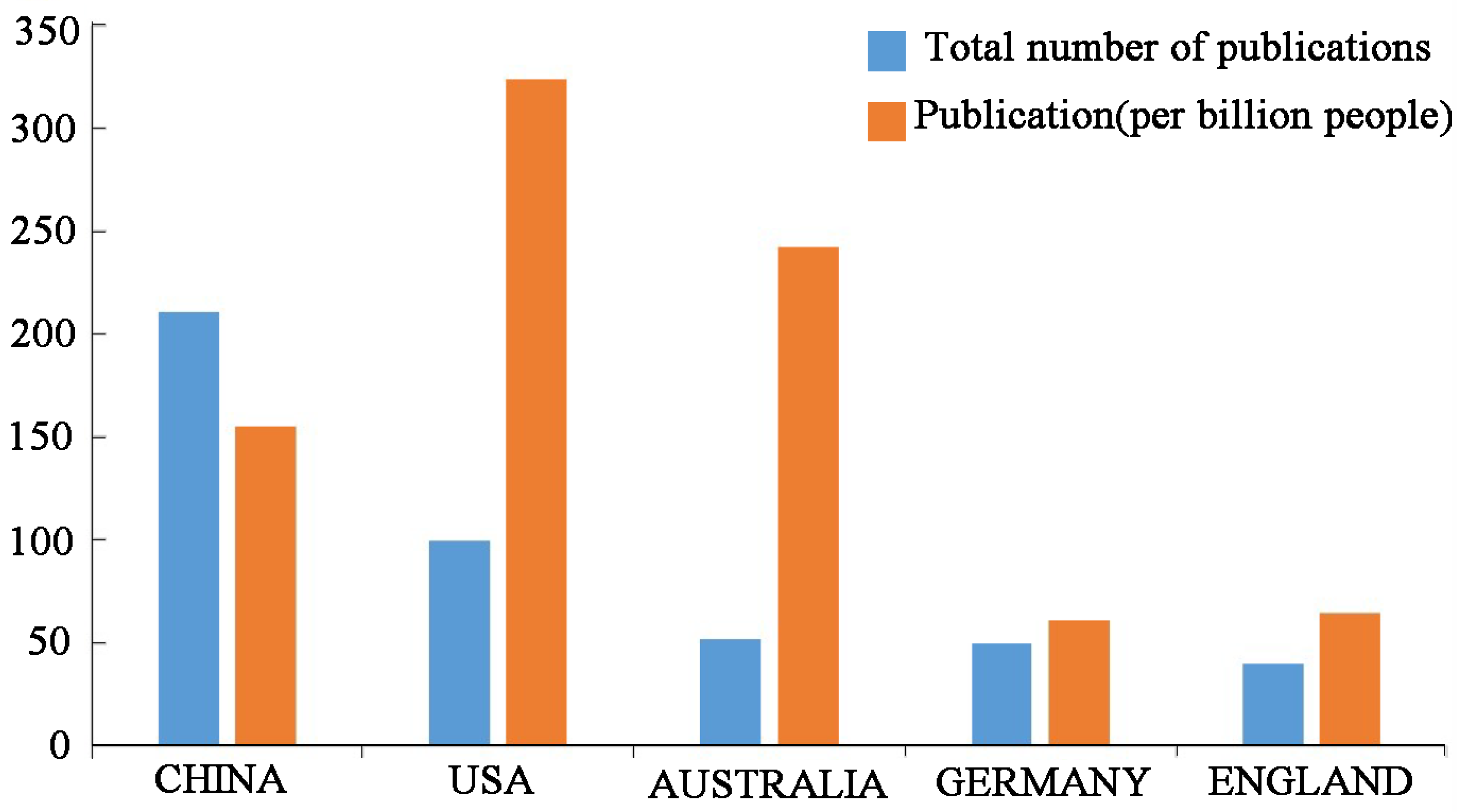

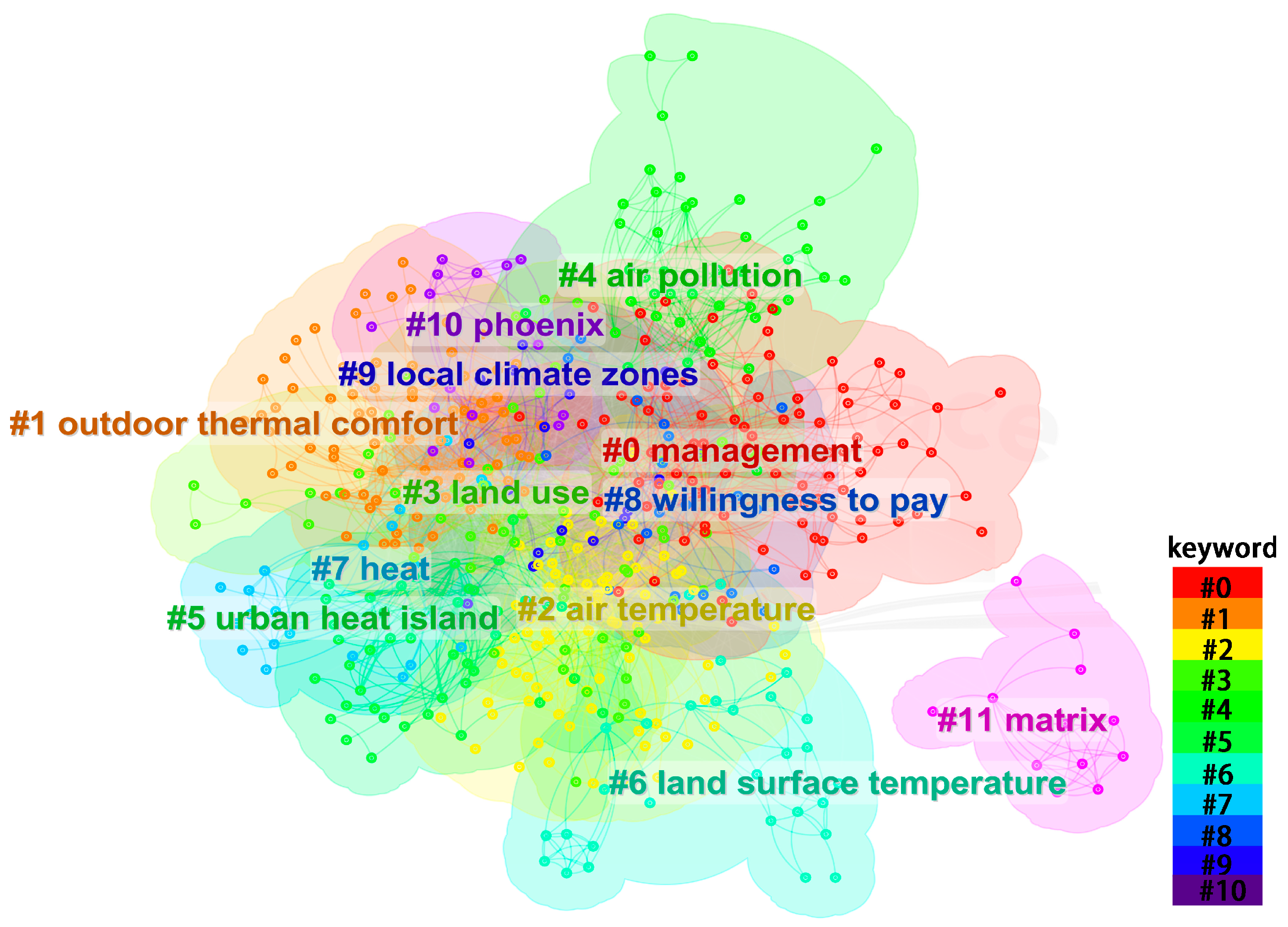
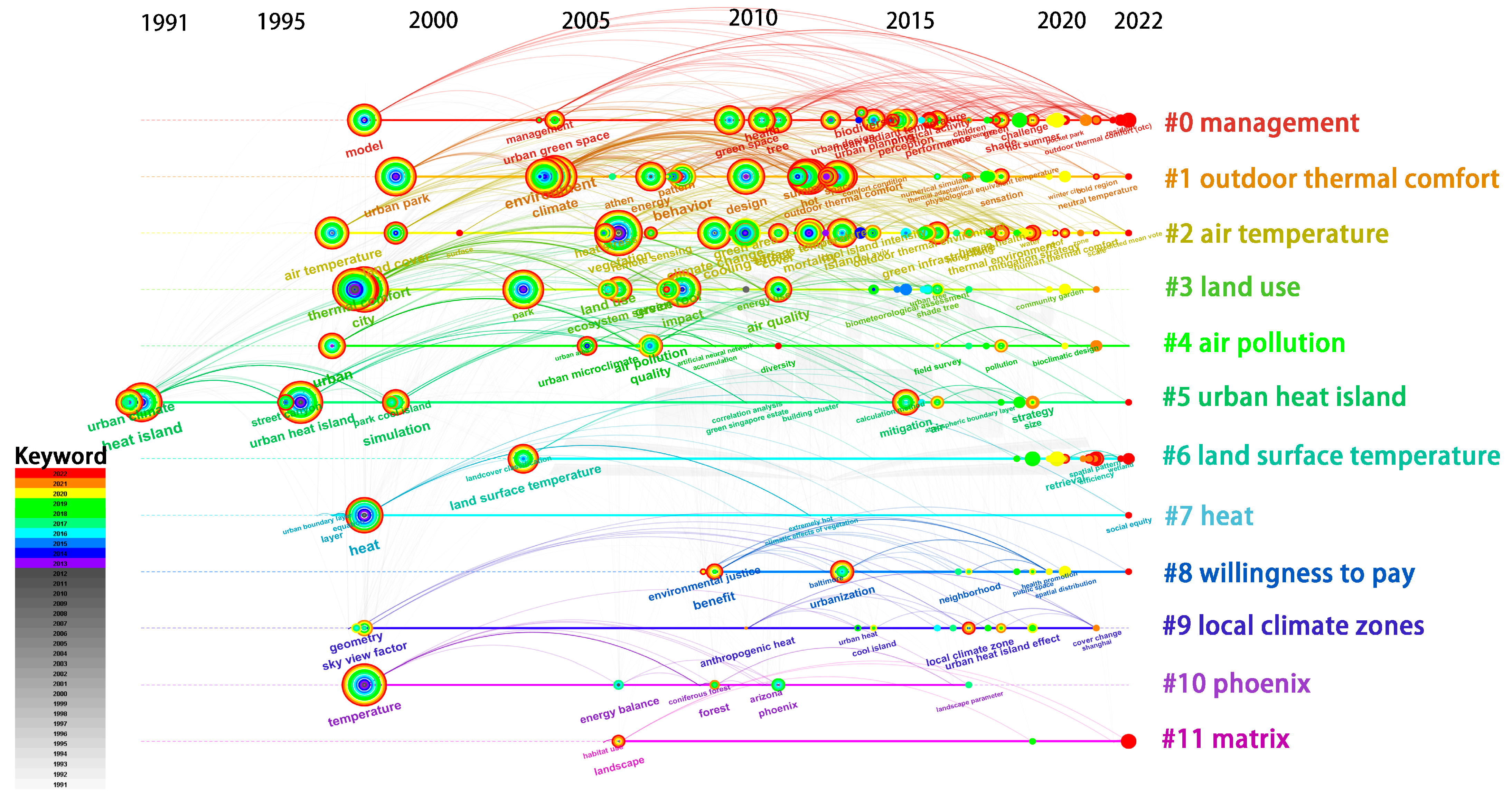
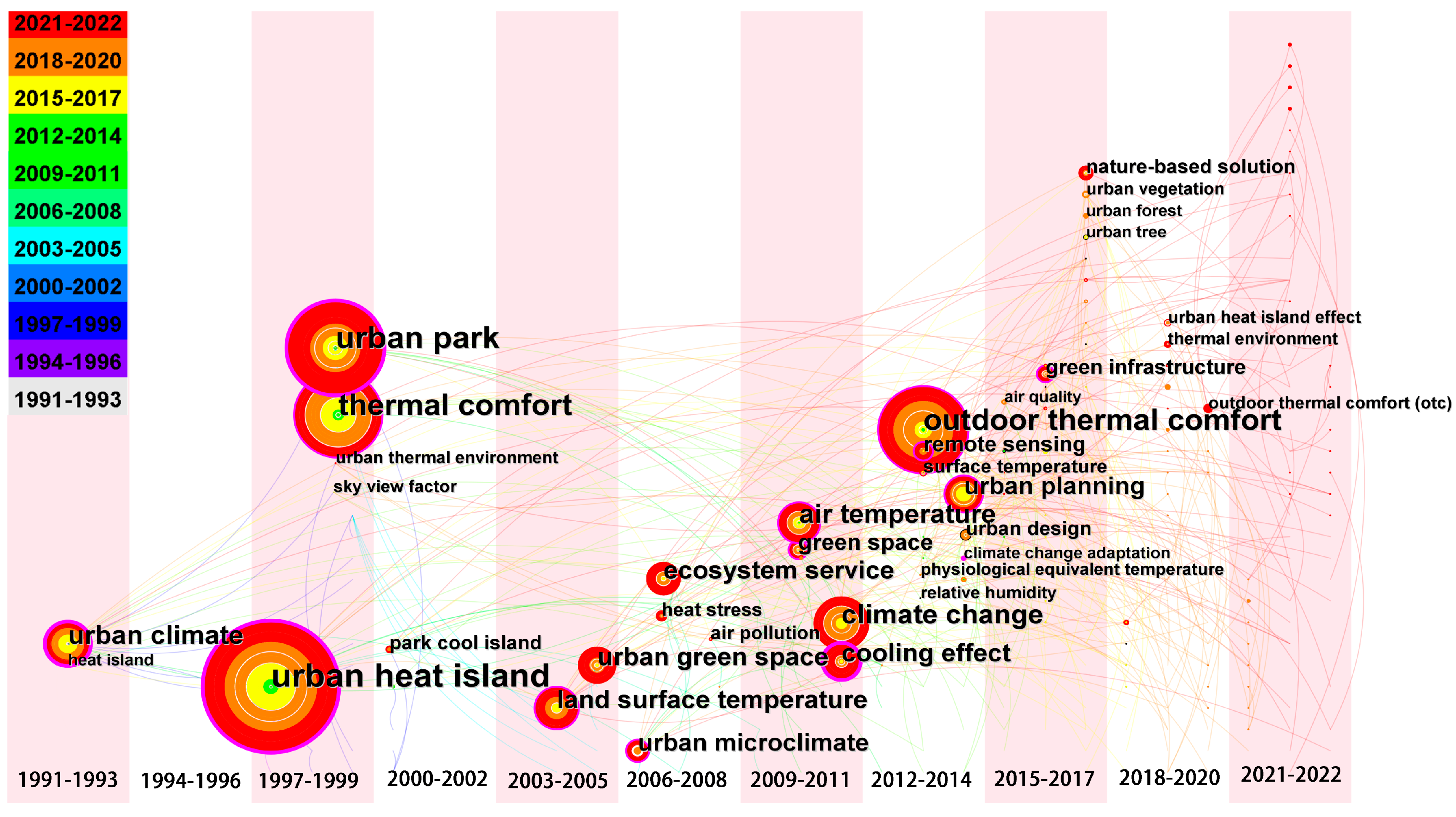
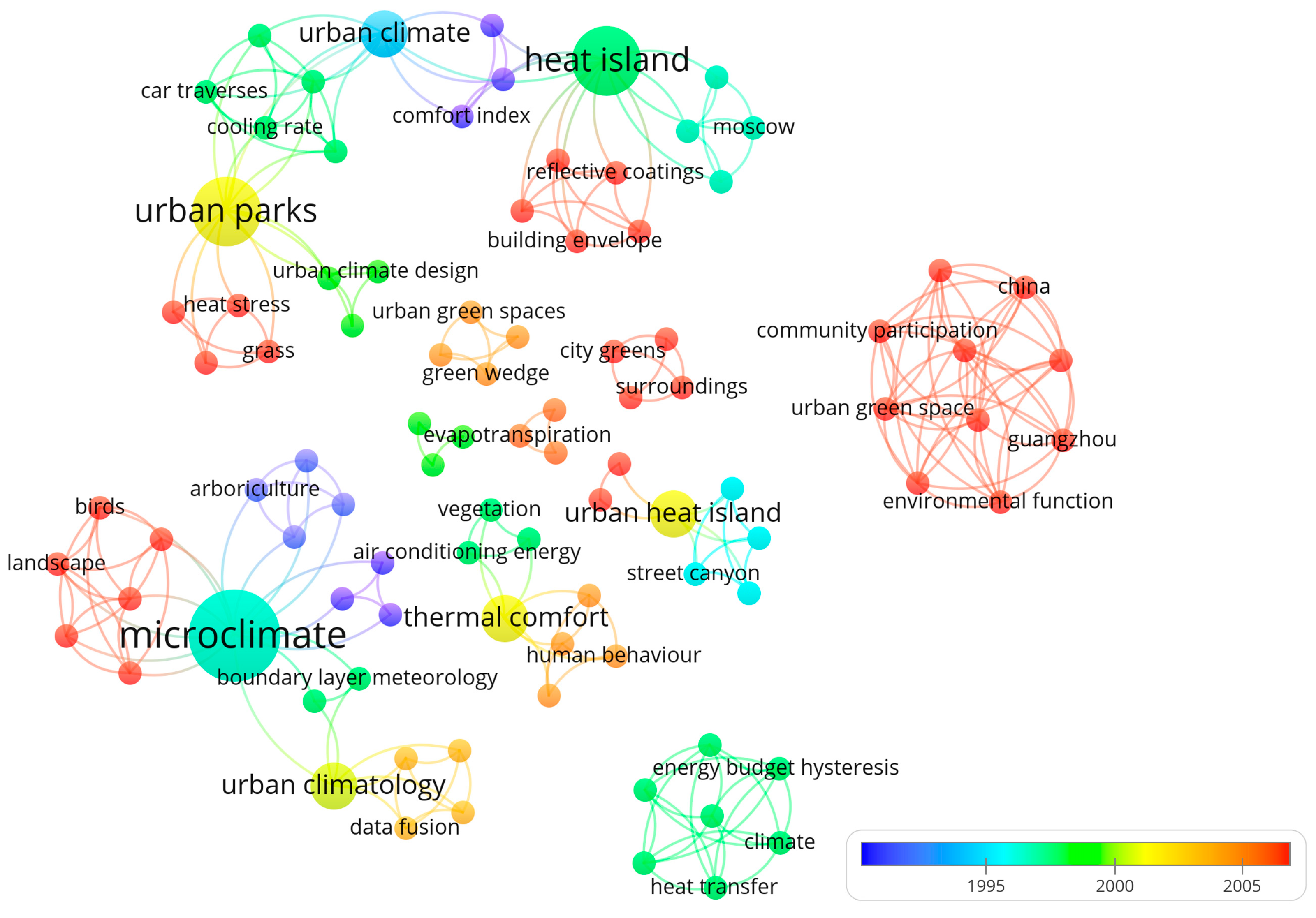

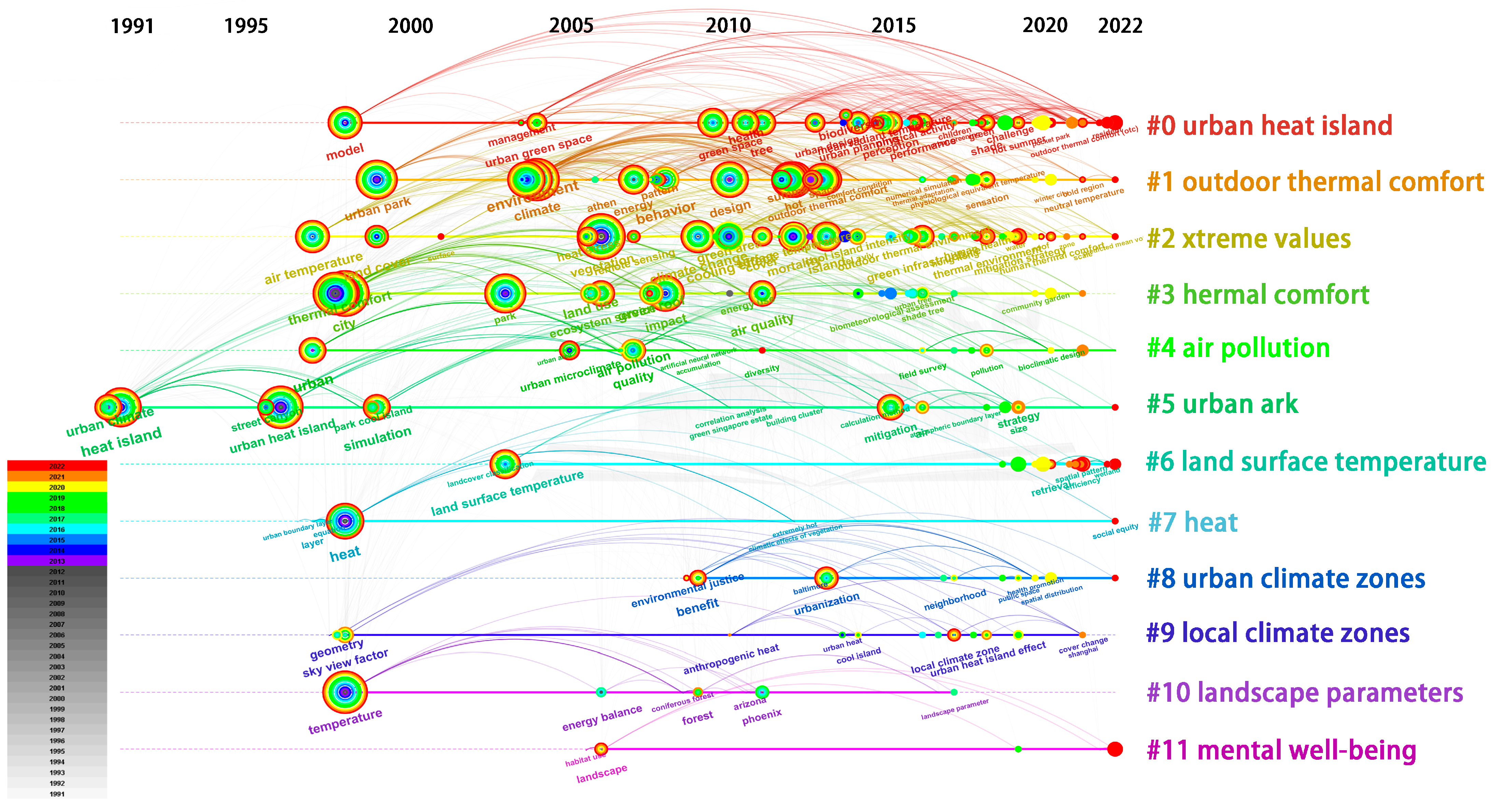

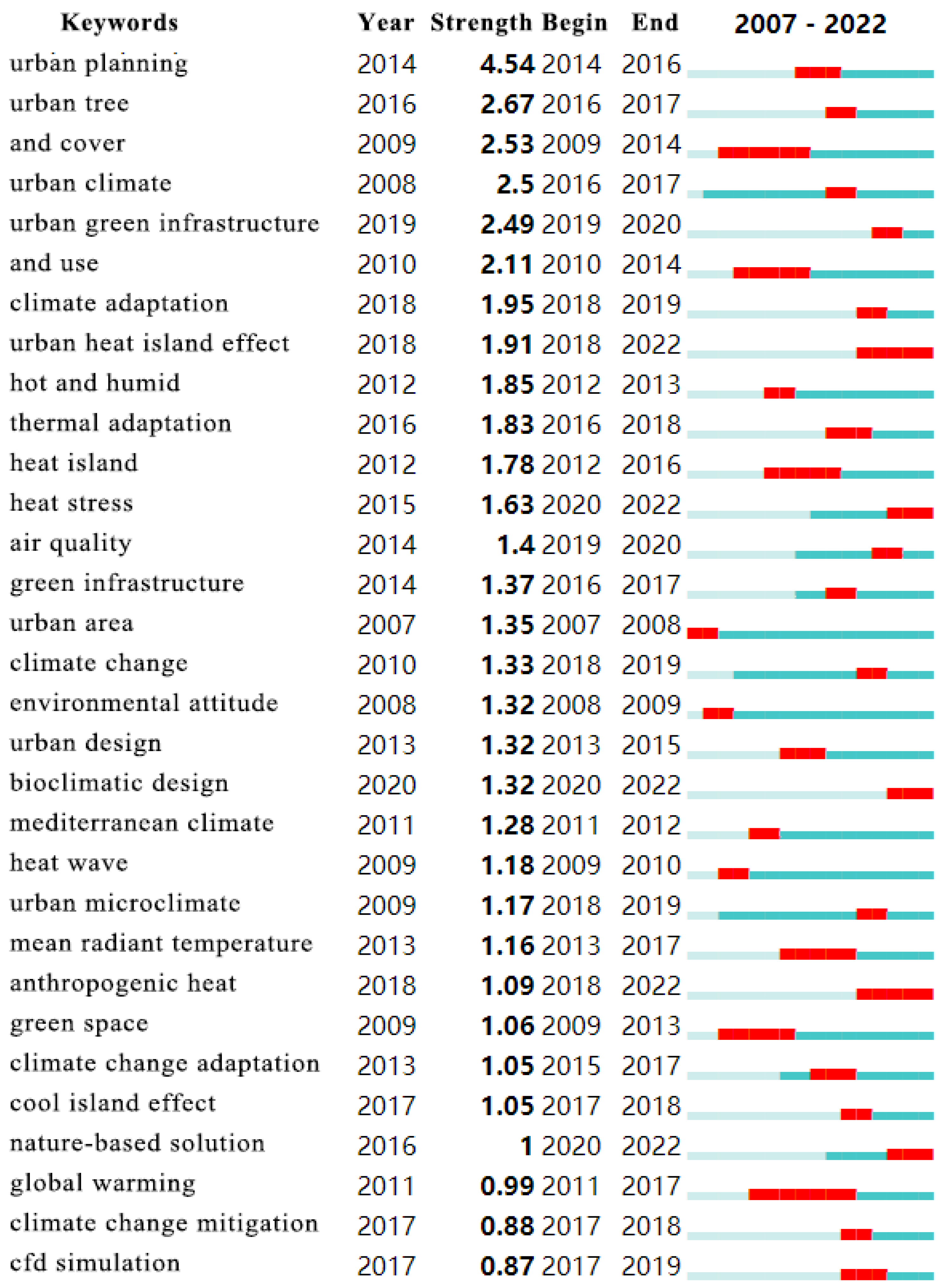
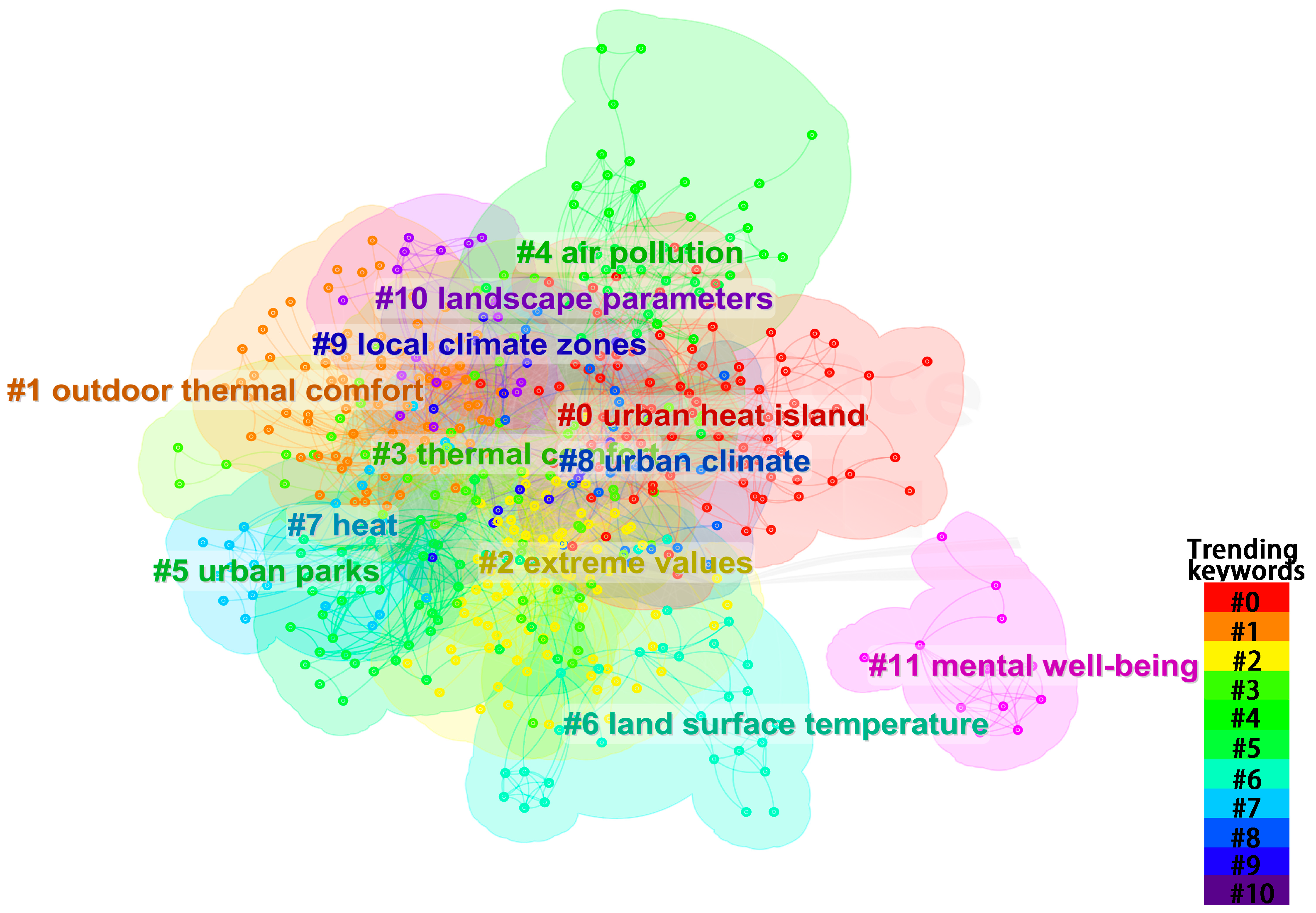
| Rank | Cluster Name | The Main Keywords | Mean Number of Years | Number of Keywords |
|---|---|---|---|---|
| 1 | manage | Management (11.99, 0.001); Nature-based solutions (8.71, 0.005); Ecosystem Services (8.21, 0.005); Cultural Ecosystem Services (7.99, 0.005); Twitter (7.99, 0.005) | 2017 | 90 |
| 2 | Outdoor thermal comfort | Outdoor Thermal Comfort (72.43, 1.0 × 10−4); Pet (24.34, 1.0 × 10−4); UTCI (16.57, 1.0 × 10−4); thermal adaptation (13.66, 0.001); Thermal sensation voting (10.97, 0.001) | 2011 | 80 |
| 3 | air temperature | Air temperature (22.04, 1.0 × 10−4); surface temperature (11.05, 0.001); outdoor thermal comfort (10.47, 0.005); thermal environment (9.75, 0.005); cooling effect (7.5, 0.01) | 2014 | 79 |
| 4 | land use | Land use (8.48, 0.005); Park (8.04, 0.005); Ecosystem Services (7.6, 0.01); ecosystem service (7.46, 0.01); thermal comfort (7.32, 0.01) | 2010 | 62 |
| 5 | air contamination | Air pollution (29.25, 1.0 × 10−4); Particulate matter (18.48, 1.0 × 10−4); Urban cooling (12.31, 0.001); Environmental management (12.31, 0.001); Urban form (12.31, 0.001) | 2012 | 44 |
| Phase Position | Year | Frequency | Keywords |
|---|---|---|---|
| 1991–1998 | 1991 | 4 | heat island |
| 1997 | 3 | urban | |
| 1998 | 3 | heat | |
| 1997 | 2 | layer | |
| 1996 | 1 | urban heat island | |
| 1998 | 1 | heat comfort | |
| 1996 | 1 | canyon geometry | |
| 1998 | 1 | car through | |
| 1998 | 1 | objective lag model | |
| 1998 | 1 | Shuifen | |
| 1999–2006 | 2004 | 3 | area |
| 1999 | 3 | heat island | |
| 2004 | 3 | climate | |
| 2004 | 2 | environment | |
| 1999 | 2 | urban park | |
| 2006 | 2 | plant | |
| 2003 | 2 | city | |
| 2006 | 1 | ecosystem service | |
| 1999 | 1 | boundary layer resistance | |
| 2003 | 1 | coastal area | |
| 2004 | 3 | area | |
| 2007–2016 | 2008 | 57 | city |
| 2007 | 54 | climate | |
| 2009 | 47 | park | |
| 2007 | 37 | urban heat island | |
| 2009 | 35 | temperature | |
| 2011 | 35 | heat comfort | |
| 2009 | 34 | plant | |
| 2008 | 32 | influence | |
| 2007 | 29 | area | |
| 2010 | 28 | heat island | |
| 2017–2022 | 2017 | 128 | influence |
| 2017 | 125 | city | |
| 2017 | 100 | urban heat island | |
| 2017 | 99 | park | |
| 2017 | 98 | climate | |
| 2017 | 93 | temperature | |
| 2017 | 85 | urban park | |
| 2017 | 82 | plant | |
| 2017 | 79 | heat comfort | |
| 2017 | 79 | climate change |
Disclaimer/Publisher’s Note: The statements, opinions and data contained in all publications are solely those of the individual author(s) and contributor(s) and not of MDPI and/or the editor(s). MDPI and/or the editor(s) disclaim responsibility for any injury to people or property resulting from any ideas, methods, instructions or products referred to in the content. |
© 2023 by the authors. Licensee MDPI, Basel, Switzerland. This article is an open access article distributed under the terms and conditions of the Creative Commons Attribution (CC BY) license (https://creativecommons.org/licenses/by/4.0/).
Share and Cite
Lin, J.; Deng, Y.; Chen, S.; Li, K.; Ji, W.; Li, W. Research Progress of Urban Park Microclimate Based on Quantitative Statistical Software. Buildings 2023, 13, 2335. https://doi.org/10.3390/buildings13092335
Lin J, Deng Y, Chen S, Li K, Ji W, Li W. Research Progress of Urban Park Microclimate Based on Quantitative Statistical Software. Buildings. 2023; 13(9):2335. https://doi.org/10.3390/buildings13092335
Chicago/Turabian StyleLin, Jiayi, Yuqian Deng, Sibo Chen, Kaiyuan Li, Wenli Ji, and Weizhong Li. 2023. "Research Progress of Urban Park Microclimate Based on Quantitative Statistical Software" Buildings 13, no. 9: 2335. https://doi.org/10.3390/buildings13092335
APA StyleLin, J., Deng, Y., Chen, S., Li, K., Ji, W., & Li, W. (2023). Research Progress of Urban Park Microclimate Based on Quantitative Statistical Software. Buildings, 13(9), 2335. https://doi.org/10.3390/buildings13092335







